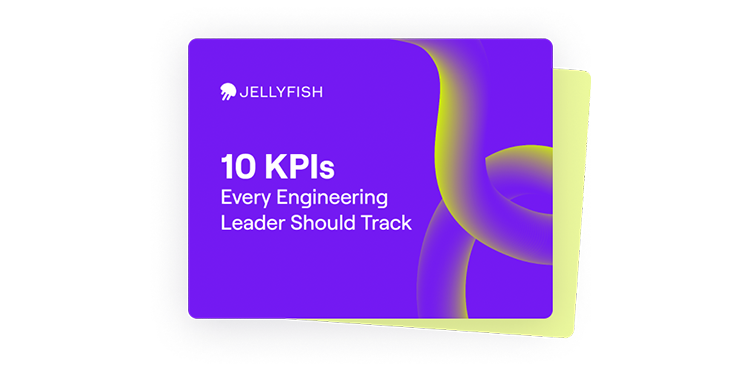Imagine an engineering team that consistently pushes out thousands of lines of code, meets every deadline, and seems highly productive on paper. But when the product finally hits the market, the reality paints a different picture – users are frustrated and the product struggles to meet business goals and customer expectations.
This scenario isn’t uncommon and highlights the drawbacks associated with traditional methodologies for measuring engineering team effectiveness. Counting code volume or even hitting deadlines can create a false sense of productivity that misses the mark.
True engineering productivity is about impact. It’s not the sheer volume of code but rather the quality and effectiveness of the solutions delivered. Engineers can be hard at work, yet if their output doesn’t align with user needs and business objectives, the effort may fall short of its potential.
In this guide, we’ll examine why traditional developer productivity metrics too often miss the mark and explain how to measure what truly matters instead.
What is Engineering Productivity?
What is Engineering Productivity?
Engineering productivity measures how efficiently engineering teams deliver high-quality, functional products. It focuses on a combination of factors, including development speed, code quality, team collaboration, and resource utilization. Optimizing engineering productivity helps identify process improvements while enhancing overall team performance.
Experienced engineering leaders know that true engineering productivity is about delivering impact. In order to deliver impact, engineering teams need to balance several factors – building the right things while providing appropriate visibility to the rest of the business, high-quality end product, and effective internal engineering collaboration.
This means that measuring engineering productivity isn’t all about speed. While velocity is important, it’s only one piece of the puzzle. We also need to consider factors like code quality, user satisfaction, and overall health and well-being of the engineering organization.
A truly productive team is one that consistently delivers value while also fostering a sustainable and fulfilling work environment.
Why Track Software Engineering Productivity?
Measuring software engineering productivity is more than just tracking numbers. It’s about gaining valuable insights into your team’s performance, identifying areas for improvement, and ultimately building better software, faster.
Here’s how it benefits both the organization and the engineers themselves:
Benefits for Engineering Organizations
- Optimize resource allocation: By understanding where your resources are going and identifying any bottlenecks, you can ensure that the right people are working on the right tasks at the right time. This leads to more efficient use of your budget and maximizes the impact of your engineering efforts.
- Accelerate time-to-market: Measuring productivity helps you streamline your development process, allowing you to deliver new features and products to market faster. This agility enables you to respond quickly to changing customer needs and stay ahead of the competition.
- Enhance customer experience: By tracking metrics related to software quality and customer satisfaction, you can ensure you’re building products that meet user needs and expectations.
- Boost revenue and profitability: Efficient software development processes directly impact your bottom line. By optimizing productivity, you can reduce development costs, minimize wasted time, and deliver more value to customers in less time.
Benefits for Engineering Teams
- Clear expectations and fair evaluations: With clear engineering performance benchmarks based on data, everyone understands what’s expected of them. This leads to fairer performance reviews that recognize individual contributions and identify areas for growth, fostering a sense of transparency and trust within the team.
- Access to necessary resources: By measuring productivity, teams can identify resource gaps and advocate for what they need to do their best work. This could include better hardware, updated software, relevant training, or simply more time to focus on complex tasks.
- Improved collaboration and communication: Measuring productivity can highlight areas where communication breakdowns or inefficient processes are hindering teamwork. This allows teams to address those issues and create a more collaborative and efficient work environment, leading to smoother workflows and better outcomes.
- Increased morale and motivation: Recognizing and rewarding individual and team accomplishments based on data boosts morale and motivation. Engineers feel a sense of ownership and pride in their work, contributing to a more positive and engaged team dynamic.
- Reduced burnout: By tracking workload, output, and other relevant metrics, teams can identify potential burnout risks and take proactive steps to prevent them. This could include adjusting workloads, promoting flexible work arrangements, and encouraging healthy work habits, leading to a more sustainable and fulfilling work experience.

10 KPIs Every Engineering Leader Should Track
Get eBookHow to Measure Software Engineering Productivity
How to Measure Software Engineering Productivity
Measuring software engineering productivity is crucial for understanding your team’s performance, identifying areas for improvement, and optimizing your development process.
Here’s a breakdown of how to approach it:
1. Establish a Holistic Metrics Program
- Gain a clear picture of your current state. Begin by assessing your current productivity levels. This involves gathering data on key metrics such as velocity, cycle time, defect rate, and deployment frequency.
- Leverage industry benchmarks. Compare your performance to industry standards to identify areas where you excel and areas where you have room for improvement. This can provide valuable context and help you set realistic goals.
- Include resource allocation and investment data. Understand how your resources are being allocated and whether your investments are aligned with your business objectives. This will help you ensure that your engineering efforts are contributing to the overall success of your organization.
2. Set Goals for Improvement and Reporting
- Set SMART goals. Based on your initial assessment and industry benchmarks, set specific, measurable, achievable, relevant, and time-bound goals for improvement.
- Align team and organizational goals. Ensure that individual team goals contribute to the overall organizational objectives. This creates a shared sense of purpose and direction.
- Develop audience-specific reporting. Create reports that are tailored to different audiences, such as the engineering team, management, and stakeholders. This ensures that everyone has the information they need to understand progress and make informed decisions.
3. Implement Programmable Workflows
- Streamline your engineering processes. Adopt tools and technologies that automate manual tasks, improve collaboration, and reduce friction in the development workflow.
- Foster better collaboration. Use tools that facilitate communication, knowledge sharing, and code review. This can help improve code quality and reduce the time it takes to get code merged and deployed.
- Remove friction in the pre-merge process. Implement automated code checks, testing, and deployment pipelines to streamline the process of getting code from development to production.
- Enhance context and visibility. Use tools that provide context to code changes, such as tags and labels, to help reviewers understand the purpose and impact of the code.
4. Select Meaningful KPIs and Metrics
- Go beyond vanity metrics. Focus on metrics that provide actionable insights and reflect the quality and impact of your team’s work.
- Consider a balanced mix of quantitative and qualitative data. While numbers are important, don’t overlook the value of feedback from users, stakeholders, and the engineers themselves.
5. Leverage the Right Tools
Utilize a variety of tools to gather and analyze data. This may include:
- Integrated development environments (IDEs): Many IDEs offer built-in metrics and analytics to track code-related productivity measures.
- Project management tools: Jira, Asana, Trello, etc., can help track progress, identify bottlenecks, and measure cycle time.
- Version control systems: Git, SVN, etc., provide data on code commits, branches, and merges, which can be used to assess team collaboration and code evolution.
- Issue tracking systems: Bugzilla, Mantis, etc., track bug reports and resolutions, providing insights into code quality and maintenance efforts.
- Custom dashboards and third-party tools: Consider developing custom dashboards or using third-party tools that aggregate and analyze data from various sources to provide a comprehensive view of your team’s productivity.
6. Analyze and Interpret Data
- Regularly review your collected data to identify trends, patterns, and areas for improvement.
- Focus on understanding the “why” behind the numbers. Don’t just look at the raw data; dig deeper to understand the factors that are influencing your team’s productivity.
7. Foster a Culture of Continuous Improvement
- Use your data to drive continuous improvement. Identify bottlenecks, optimize processes, and implement changes to enhance your team’s efficiency and effectiveness.
- Encourage feedback and collaboration. Involve your engineers in the process of measuring and improving productivity. This will help create a culture of shared ownership and continuous learning.
14 Software Engineering Productivity Metrics Leaders Should Consider Tracking
14 Software Engineering Productivity Metrics Leaders Should Consider Tracking
Tracking software engineering productivity metrics is crucial for understanding your team’s performance, identifying bottlenecks, and continuously improving your development process.
However, it’s important to choose metrics that align with your goals and provide meaningful insights.
Here are some key software engineering productivity metrics you should consider tracking:
1. DORA Metrics
These are a set of four key metrics developed by the DevOps Research and Assessment (DORA) group. They are widely recognized and provide a good overview of your software delivery performance:
- Deployment Frequency: How often you successfully release code to production. Higher frequency generally indicates better efficiency and responsiveness to customer needs.
- Lead Time for Changes: The time it takes for a code change to go from commit to running in production. Shorter lead times mean faster delivery and feedback loops.
- Change Failure Rate: The percentage of deployments that cause a failure in production. A lower rate indicates higher quality and stability.
- Time to Restore Service: How long it takes to recover from a production failure.
Faster recovery times minimize downtime and customer impact.
2. Cycle Time
This measures the time it takes to complete a specific task or piece of work, from start to finish. You can track cycle time for different stages of development, such as coding, reviewing, and testing, to identify bottlenecks.
For example, shorter cycle times signify a more efficient development process, leading to faster delivery of features, increased revenue, and improved customer satisfaction.
To optimize cycle time, break it down into its component parts (coding, pickup, review, deploy) and identify bottlenecks in each stage. This allows you to address specific inefficiencies, such as slow code reviews or manual testing processes.
3. Velocity
This measures the amount of work a team completes within a given time period, typically a sprint. It can be measured in story points, features, or other units of work. Velocity helps you understand your team’s capacity and predict future performance.
4. Code Quality Metrics
These measure the quality and maintainability of your codebase. Examples include:
- Code Coverage: The percentage of your code covered by automated tests. Higher coverage generally indicates better quality and reduces the risk of bugs.
- Code Complexity: Measures the complexity of your code, which can impact readability and maintainability. High complexity can make code harder to understand and modify.
- Code Review Metrics: Track the effectiveness of your code review process, such as review time, number of comments, and acceptance rate.
5. Flow Metrics
These focus on the flow of work through your development process and identify areas where work is getting stuck. Examples include:
- Work in Progress (WIP): The number of tasks currently in progress. High WIP can indicate bottlenecks and inefficiencies.
- Flow Efficiency: The ratio of time spent actively working on tasks versus time spent waiting. Higher efficiency indicates a smoother flow of work.
6. Merge Frequency
This metric tracks how often code changes are integrated into your main codebase.
A high merge frequency is a strong indicator of a healthy development pipeline with minimal bottlenecks in the code review process. Frequent merges enable faster feedback loops, quicker iteration, and ultimately, a faster delivery of value to your users.
To boost merge frequency, consider automating approvals for low-risk changes, providing clear context to reviewers, and optimizing your code review workflows.
7. Accuracy Scores
Accuracy scores reflect how well your team estimates and delivers on project plans. There are two key components:
- Planning accuracy: Measures the amount of work completed in an iteration compared to the amount planned.
- Capacity accuracy: Measures all completed work (planned and unplanned) as a ratio of planned work.
High accuracy scores are crucial for setting realistic expectations, delivering projects on time, and managing resources effectively. Leverage project tracking tools and analyze historical data to improve your estimation accuracy and avoid project delays.
8. Resource Allocation
This metric tracks how your engineering resources (time, talent, budget) are being utilized.
This metric is important for engineering managers because it helps you ensure your investments are aligned with your business goals.
To optimize resource allocation, track time spent on different activities, analyze your investment profile across different categories (new features, bug fixes, etc.), and ensure a balanced workload distribution across the team.
9. Weekly Issues Resolved per Engineer
This is the number of issues, bugs, or tickets resolved by each engineer on a weekly basis.
This metric provides insights into individual engineer productivity, workload distribution, and potential bottlenecks. It helps identify high-performing individuals, areas where engineers might be struggling, and whether work is evenly distributed across the team.
To improve this metric, analyze workload distribution to ensure no one is overloaded. Provide support and mentorship to engineers who are resolving fewer issues. Consider adjusting task assignments to better balance workloads.
10. Weekly Comments per Engineer
This is the number of comments made by an engineer during code reviews each week. It reflects the level of engagement and collaboration within the team during code reviews. A higher number of comments can indicate thoroughness, knowledge sharing, and a commitment to code quality. Encourage active participation in code reviews by providing clear guidelines and fostering a culture of constructive feedback.
11. Weekly PR Reviews per Engineer
This is the number of pull requests (PRs) reviewed by each engineer weekly. It indicates an engineer’s involvement in the code review process and their contribution to maintaining code quality and standards. It also helps identify potential bottlenecks in the review process.
12. Defect Rate
This is the number of defects found in the code. A lower defect rate generally means higher quality software and a better user experience.
To reduce your defect rate, consider:
- Shift-left testing: Move testing earlier in the development process to catch bugs sooner.
- Invest in automated testing: Automate repetitive tests to improve coverage and efficiency.
- Enforce coding standards: Use linters and code analysis tools to ensure code consistency and identify potential issues.
- Prioritize code reviews: Make code reviews a mandatory part of your development process.
13. Code Complexity
This measures how difficult the code is to understand and maintain. Think of it as a measure of how tangled and convoluted your codebase is. Keeping complexity low improves maintainability, reduces technical debt, and makes it easier for developers to work with the codebase.
High code complexity leads to:
- Increased bugs: Complex code is harder to understand and, therefore, more prone to errors.
- Slower development: It takes longer to make changes to complex code, slowing down development and increasing costs.
- Difficulty onboarding new developers: Complex code can be a major barrier to new team members getting up to speed.
- Higher risk of technical debt: Complex code is harder to refactor and maintain, leading to an accumulation of technical debt.
14. Mean Time to Resolution (MTTR)
This is the average time it takes to resolve a bug. A lower MTTR means faster resolution of issues, reduced downtime, and improved user satisfaction.
A high MTTR can indicate:
- Inefficient bug tracking: Is there a clear process for reporting, triaging, and prioritizing bugs?
- Lack of collaboration: Are developers struggling to get the help they need to resolve issues?
- Knowledge silos: Is knowledge concentrated in a few individuals, creating bottlenecks when they are unavailable?
- Complex debugging: Is the codebase difficult to debug, making it time-consuming to find the root cause of issues?
How to Improve Engineering Efficiency: 7 Best Practices
How to Improve Engineering Efficiency: 7 Best Practices
Engineering efficiency is the ability of an engineering team to produce high quality products relative to the costs of running the team. Improving engineering efficiency often involves focusing on optimizing processes, workflows, and resource allocation to achieve efficiency.
By leveraging engineering productivity metrics and measurement techniques, development teams can identify areas for improvement and implement strategies to enhance engineering efficiency.
To improve engineering efficiency using engineering productivity, the following steps can be taken:
1. Track the Right Engineering Metrics
- The metrics you define should be outcome-focused. Don’t just measure activity (i.e. lines of code, hours worked). Prioritize metrics tied to value delivery, such as cycle time, defect rate and customer satisfaction.
- Metrics should reflect the team’s goals. A team focused on new features will have different metrics than a team fixing bugs.
2. Identify Bottlenecks and Inefficiencies
- Use Kanban boards, flowcharts, etc., to see where work piles up.
- Gather Data. Is code review taking ages? Are deployments constantly delayed? Tools like Jellyfish can provide these insights automatically.
- Sometimes the biggest bottlenecks are things metrics can’t capture, like unclear requirements or poor communication. So make sure you also get input from your team.
3. Streamline Processes and Workflows
Evaluate existing processes and workflows to identify opportunities for optimization.
- Automation is key. Automate repetitive tasks, streamline code review processes, and eliminate unnecessary steps. This helps reduce manual effort, minimize errors, and improve overall productivity.
- Kill redundancy.Are multiple people doing the same checks? Can meetings be shorter or less frequent?
- Optimize existing tools. Are developers using the best IDEs, version control, etc.? Even small improvements add up.
4. Allocate Resource Effectively
Ensure that resources, such as developers, tools, and equipment, are allocated efficiently.
- Assign tasks based on strengths. For example, don’t have a senior developer fixing typos.
- Evenly distributed work prevents burnout and keeps things flowing smoothly.
- Ensure everyone has the hardware and software they need to do their best work.
5. Foster Collaboration and Knowledge Sharing
- Encourage clear communication. Project management tools, chat apps, and regular stand-ups keep everyone informed.
- Encourage knowledge sharing. Code reviews, pair programming, and internal wikis prevent siloed knowledge.
6. Continuous Learning and Improvement
Provide opportunities for professional growth and skill development. Encourage engineers to stay updated with the latest technologies and industry best practices. This helps enhance their performance, efficiency, and ability to deliver high-quality results.
7. Regular Performance Evaluation and Feedback
Implement a performance evaluation system that measures individual engineer performance against established metrics. Provide constructive feedback to help individuals identify areas for improvement and support their professional growth.
Drive Engineering Impact with Jellyfish
Drive Engineering Impact with Jellyfish
Do any of these scenarios sound familiar?
- We’re shipping features, but is it fast enough? You’re delivering, but have a nagging feeling that your team could be more efficient. Release cycles feel longer than they should, and you’re losing ground to competitors.
- Where exactly is time being wasted? You know there are bottlenecks, but pinpointing them feels like searching for a needle in a haystack. Code reviews drag on, testing is a black box, and deployments are always stressful.
- Are we working on the right things? You have a roadmap, but are you prioritizing the most impactful projects? Are your senior engineers stuck in meetings or bogged down with trivial tasks?
If these challenges resonate, you’re not alone. Many engineering leaders lack the visibility and insights they need to truly optimize their organization’s performance.
Our platform provides a level of visibility and control you’ve never experienced before, empowering you to:
- Uncover the true cost of development: See exactly how engineering resources are being allocated across projects, features, and even individual tasks. Identify cost drivers, optimize spending, and accurately measure the ROI of your engineering investments.
- Diagnose and resolve bottlenecks: Go beyond surface-level metrics and pinpoint the root causes of slowdowns. Is it inefficient code review processes, flaky tests, or cumbersome deployment pipelines? Jellyfish helps you identify and address the bottlenecks that are hindering your team’s velocity.
- Align engineering with business priorities: Connect engineering work to strategic business objectives. Track progress towards goals, measure the impact of different initiatives, and ensure your team is focused on the work that delivers the most value.
- Foster a culture of continuous improvement: Track trends over time, measure the impact of changes, and identify areas for ongoing optimization. Jellyfish helps you build a data-driven culture where continuous improvement is embedded in your engineering DNA.
With Jellyfish, you can finally:
- Ship faster: Reduce cycle times and get innovations to market quicker by streamlining your development process.
- Increase efficiency: Optimize resource allocation, eliminate waste, and maximize the output of your engineering team.
- Improve predictability: Forecast project timelines with greater accuracy and confidence.
- Boost developer experience: Give your team the tools and insights they need to do their best work and feel a sense of ownership.
- Communicate engineering value: Demonstrate the impact of engineering on business outcomes and secure the resources you need to succeed.
Don’t let another day go by without the insights you need to drive engineering success.
Take the next step.
Discover how Jellyfish can enable your teams to work smarter, feel empowered, and deliver better outcomes for the business.

Interested in learning more about Jellyfish?
See how Jellyfish helps data-driven engineering teams ship better software faster and focus on what matters most to the business.
Tour the ProductAbout the author

Lauren is Senior Product Marketing Director at Jellyfish where she works closely with the product team to bring software engineering intelligence solutions to market. Prior to Jellyfish, Lauren served as Director of Product Marketing at Pluralsight.




